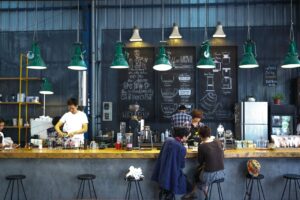

Experience Design is most concerned with the memory a person makes when they have an experience that involves design. There’s no specific technology or medium for experience design—so experience designers usually have one area of expertise and are generalists in lots of other different areas. Because the total experience and the resulting memory are what matters for experience design, this approach often involves multi-sensory design that balances both the “getting the job done” with the “enjoying the journey” of the user experience.
“Experiences” aren’t clearly defined, so experience designers use a range of methods to communicate their process. These methods include:
- Field research
- Experience maps
- Personas
- Whiteboarding and storyboarding
- Prototypes
Got a community that wants to improve the voting experience? Maybe there’s a hot dog stand that wants to explore a delivery service. What if we could improve access to recording hopes and dreams for advance care planning? Experience design can do it.
Experience Design Outcomes
A few Experience Design outcome examples:
- MagicBands at Walt Disney World (seriously!).
- Smartphone apps that invite users to play along.
- Plush animal toys that help relieve stress.
Experience Design: A Deeper Dive
Designing for experiences has been a source of much interest over the last 20 years. In their 1999 book The Experience Economy, economists Joseph Pine II and James H. Gilmore presented that the most effective way companies could differentiate themselves in the market was through offering experiences that people value. In 2000, User Experience Designer Jesse James Garrett introduced The Elements of User Experience, a model stating that users’ needs, goals, and values are just as important as website functionality. Business innovation expert Clayton Christensen summarized decades of work with multinational corporations in his 2016 book, Competing Against Luck: The Story of Innovation and Customer Choice. In this book, Christensen and co-authors concluded that creators should focus on understanding people’s experiences with products and services. While titles like graphic, industrial, interaction, or service designer describe designers’ expertise based on what they create, experience designer is a title that more accurately reflects the future of design.
Experience Design considers what people think, feel, and do when they complete activities. Every activity is different because people and situations are complex. For example, checking a child in at a chaotic children’s hospital emergency room can involve detailed tasks like reading and signing papers. Designers can create materials that will make this task easier. However, Experience Designers would take into account that this activity can spark intense emotions. Parents and patients often experience fear and anxiety, especially in a high-intensity place like a hospital emergency room. An Experience Design approach in this scenario could produce redesigned forms that are easier to complete but it could also lead to creating quiet, comfortable spaces for check-in or cellphone privacy booths for parents who need to coordinate care for other children. Regardless of the design outcomes, the goal in this scenario is to help people get the care they need while reducing emotional discomfort.
Experience Design endeavors to create valuable and meaningful experiences that align with peoples’ diverse needs, values, and preferences. This involves research beyond just demographics and buying behaviors to discover real and perceived factors that affect people when they use design in different situations. Research for Experience Design involves letting people tell their stories. Designing for experiences can involve designing lighting, directing sound design, creating print materials, or other multi-sensory design outcomes. Experience Design brings together teams that are willing to collaborate and cross-disciplinary boundaries. Some Experience Designers are experts in traditional design such as graphic and interaction design. Others possess expertise in areas like ergonomics, cultural anthropology, linguistics, and social psychology. Together, teams innovate and test products, services, and systems that are relevant, valuable, and meaningful—all because people deserve better experiences.
Experience Design Projects
Resources
WTF is Experience Design? – UX Collective
What is Product Design? – Erik Ericcson: Facebook
Remaking Ford into a user experience-driven company – Ford Motors on Experience Design
Experience Design: When Innovation Isn’t Enough – Patrick Newberry of Method at Wired
Experience design: An in-depth guide to what this mix of branding, UX, service design, and more really means – David Eveleigh-Evans, Method
References
Joseph Pine, B., & Gilmore, J. H. (2011). The Experience Economy. Harvard Business Press.
Robert Rossman, J., & Duerden, M. D. (2019). Designing Experiences. Columbia University Press.